There is a persuasive need to open up the Mid-Infrared (MIR) part of the spectrum for spectroscopic sensing in fields as diverse as bio- and medical photonics, manufacturing control, environmental monitoring and security.
The MIR covers important atmospheric windows and strong fundamental absorptions of molecular species. The University of Nottingham has world-class facilities for the synthesis, and physical and optical characterisation, of new MIR glasses, and the fabrication and testing of fibre-optic and photonic integrated devices based on them.
However, to exploit the MIR requires new coherent narrow, and broadband, sources and sensors. A major aim is to create a new paradigm in real-time MIR medical-imaging and sensing for medical endoscopy and dermoscopy targeting the early diagnosis of cancer and real-time imaging of cancer margins during surgery. The MIR Photonics Group (that seamlessly links the GGIER with the Advanced Materials Research Group) was funded under the FP7 EU “MINERVA” (Mid- to NEaR-infrared spectroscopy for improved medical DiAgnostics) project 2012-2017 to pursue these goals.
Our work has included a comprehensive study of the material refractive index dispersion data to guide the design of chalcogenide glass step index fibres, and the fitting of the refractive index data with models that can be used effectively within our modelling tools. Extensive numerical investigations have been undertaken to explore some of the possibilities for obtaining mid-infrared luminescence and laser action in rare earth doped chalcogenide glass fibres, and experimental techniques developed for extracting modelling parameters. Presently funded work includes the development of (i) cold-container processing to enable the rapid manufacture of mid-infrared glasses with hyper-purity (EPSRC, COld-cOntainer processing for Long-wavelength mid-infrared fibre optics. (COOL), 2017-2020) and (ii) robust mid infrared spontaneous emission sources with tailored output spectrum shape (National Science Centre Poland, Polonez grant to S Sujecki, 2017-2019)
Members of the GGIEMR play key managerial and technical leadership roles within the COST Project MP1401 “Advanced fibre laser and coherent source as tools for society, manufacturing and lifescience”.
Research images
Chalcogenide-glass mid-infrared waveguides and optical fibres
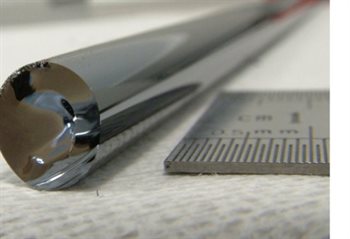
A co-extruded optical fibre preform to be drawn into a step-index chalcogenide-glass optical fibre. Our extruded rods typically show a tolerance in outside diameter of ± 4 microns on a 5 mm diameter rod over a rod length of 250 mm.
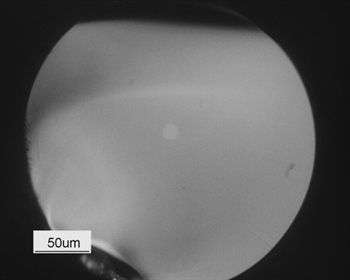
A small-core step-index chalcogenide-glass optical fibre. The fibre is suitable for mid-infrared supercontinuum generation (MIR-SCG) and has a numerical aperture (NA) of 1. We make small core fibre to within 1 micron of the designed core and from NA 0.3 to 1.8.
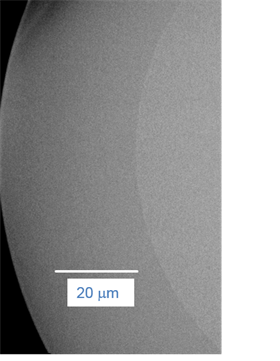
A multimode step-index chalcogenide-glass optical fibre. The fibre was prepared via co-extrusion of the core and cladding glasses to form a core/clad. fibreoptic preform.
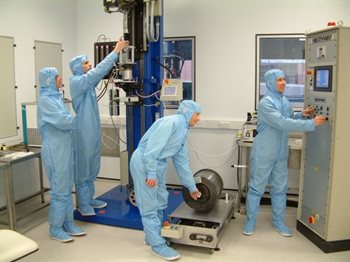
In-house fibre-drawing of mid-infrared transmitting chalcogenide-glass fibres on our customised (Heathway) optical fibre drawing tower, housed in a Class-10,000 Clean Room Fab. Lab.
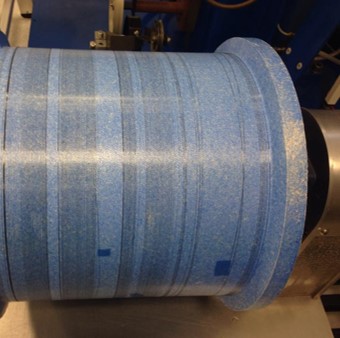
Reel of chalcogenide-glass fibre drawn in-house.
A major achievement in MIR supercontinuum generation in fiber from 1.4 mm to 13.3 mm spectral range, to cover the fundamental biomolecular absorption bands.
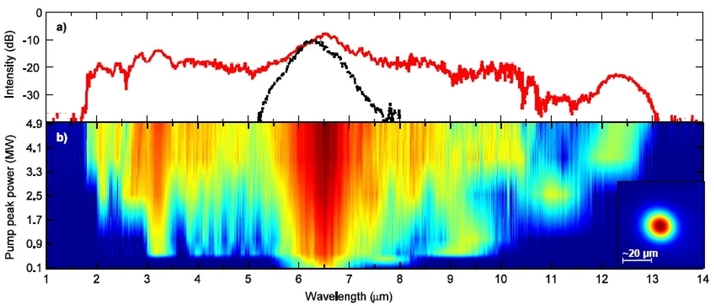
Pumped selenide fiber at 4.5 or 6.3 um with OPA. Petersen et al. NAT. PHOTON. 2014
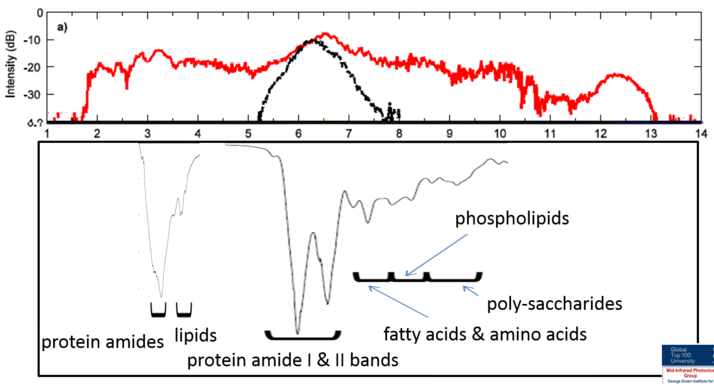
Seddon, “Biomedical Applications --using MIR-SC Optical Biopsy”, in Deep Imaging in Tissue and Tissue-Like Media with Linear and Nonlinear Optics, eds. Alfano & Shi, Pan Stanford Pub. Singapore, 2017
L. Sójka, Z. Tang, D. Furniss, H. Sakr, E. Bereś-Pawlik, A. B. Seddon, T. M. Benson, S. Sujecki “Numerical and experimental investigation of mid-infrared laser action in resonantly pumped Pr3+ doped chalcogenide fibre”, Opt Quant Electron 49:21, 2017, DOI 10.1007/s11082-016-0827-0.
Y. Fang, D. Jayasuriya, D. Furniss, Z. Q. Tang, Ł. Sojka, C. Markos, S. Sujecki, A. B. Seddon, T. M. Benson “Determining the refractive index dispersion and thickness of hot-pressed chalcogenide thin films from an improved Swanepoel method” Optical and Quantum Electronics 49:237, 2017, DOI 10.1007/s11082-017-1057-9.
L. Sojka, Z. Tang, D. Furniss, H. Sakr, Y. Fang, E. Beres-Pawlik, T. M. Benson, A. B. Seddon, and S. Sujecki, "Mid-infrared emission in Tb3+-doped selenide glass fiber," J. Opt. Soc. Am. B 34, A70-A79, 2017.
H. Sakr, Z. Tang, D. Furniss, L. Sojka, S. Sujecki, T M Benson, A. B. Seddon “Promising emission behavior in Pr3+/In selenide-chalcogenide-glass small-core step index fiber (SIF)” Optical Materials, 67, 98-107, 2017.
Z. Tang, V.S. Shiryaev, D. Furniss, L. Sojka, S. Sujecki, T.M. Benson, A.B. Seddon and M.F. Churbanov, “Low loss Ge-As-Se chalcogenide glass fiber, fabricated using extruded preform, for mid-infrared photonics,” Optical Materials Express 5 (8) 1722-1737 2015.
Z. Tang, D. Furniss, M. Fay, N. Neate, Y. Cheng, E. Barney, L. Sojka, S. Sujecki, T. Benson and A.B. Seddon, “First identification of rare earth oxide nucleation in chalcogenide glasses and implications for fabrication of mid-infrared active fibres.”, J Am Ceram Soc 97 (2) 432-441 2014.
A.B. Seddon, N.S. Abdel-Moneim, Z.G. Lian, W.J. Pan, D. Furniss, C.J. Mellor, T. Kohoutek, J. Orava, T. Wagner and T.M. Benson, “Mid-infrared integrated optics: versatile hot embossing of mid-infrared glasses for on-chip planar waveguides for molecular sensing”, Optical Engineering 53 (7) 071824 2014.
H.G. Dantanarayana, N. Abdel-Moneim, Z. Tang, L. Sojka, S. Sujecki, D. Furniss, A.B. Seddon, I. Kubat, O. Bang, and T.M. Benson “Refractive index dispersion of chalcogenide glasses for ultra-high numerical-aperture fiber for mid-infrared supercontinuum generation.” Optical Materials Express 4 (7) 1444-1455, 2014.
C.R. Petersen, U. Møller, I. Kubat, B. Zhou, S. Dupont, J. Ramsay, T. Benson, S. Sujecki, N. Abdel-Moneim, Z. Tang, D. Furniss, A. Seddon and O. Bang, Mid-infrared supercontinuum covering the 1.4–13.3 μm molecular fingerprint region using ultra-high NA chalcogenide step-index fibre, Nature Photonics 8 830–834, 2014.
- Zhuoqui Tang (2012) Research Fellow, University of Nottingham.
- Joris Lousteau, Research Staff, University of Southampton.
- Kaustav Bhowmick, Assistant Professor, Amrita University, India.
- Jessica Butterworth (2017), Training and Business Development Assistant, Cambridge Medical Robotics Limited
- Hesham Sakr (2016) Lecturer (Senior Instructor), University of Science and Technology at Zewail City 6th of October, Egypt
- Lukasz Sojka, Lecturer, Wroclaw University of Technology, Poland.
- Zhenggang Lian (2010) Director, Wuhan Optics Valley Measurement Centre, China